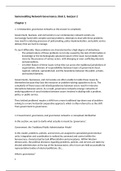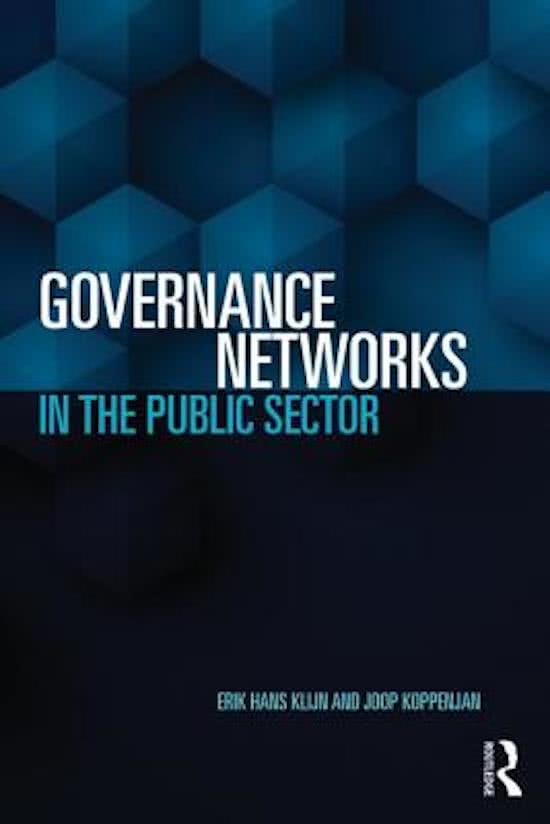Samenvatting Network Governance, blok 2, leerjaar 2
Chapter 1
1.1 Introduction: governance networks as the answer to complexity
Government, business, and civil society in our contemporary network society are
increasingly faced with complex societal problems. Attempts to deal with these problems
may result in enduring processes of policymaking, policy implementation, and public service
delivery that are hard to manage.
To say it differently: these problems are characterized by a high degree of wickedness:
- The wicked nature of these problems is not only caused by the lack of information or
knowledge or the technologically advanced nature of the issue; but probably even
more by the presence of various actors, with diverging or even conflicting interests
and perceptions.
- A further feature of these issues is that they cut across the traditional jurisdictions of
organizations, divisions of responsibilities between layers of government (local,
regional, national, supranational), and the boundaries between the public, private,
and societal domains.
Governments, businesses, and civil society are often unable to tackle these issues by
themselves because they lack the resources or problem-solving capacities to do so. The
complexity of these issues and interdependencies between actors result in intensive
interactions between actors. As a result, governance networks emerge: networks of
enduring patterns of social relations between actors involved in dealing with a problem,
policy, or public service.
They (wicked problems) require a shift from a more traditional top-down way of problem
solving to a more horizontal cooperative approach, which is often referred to as the shift
from government to governance.
1.2 Government, governance, and governance networks: a conceptual clarification
In this section, we seek to clarify what actually is meant by ‘governance’.
Government: the Traditional Public Administration Model
In this model, problems, policies, and services are assigned to specialized governmental
units. Integration and coordination is realized by command and control within the
bureaucracy, characterized by task differentiation and procedures. Within Western
democracies, the political decisions regarding problems, policies, and services are taken by
elected administrators at the top of the bureaucracies, who in turn are held accountable by
representative bodies of elected politicians. Etc…
What is governance?
1
,We conclude from the above discussion that governance should be understood as
governance within governance networks, or in other words: network governance.
(New Public Management emphasizes central steering and political control, showing in that
respect similarities with the hierarchical orientation of the Traditional Public Administration
Model, whereas governance tends to emphasize the limits of central control.)
Governance is the process that takes place within governance networks.
1.3 Defining governance networks and network governance
We define governance networks as more or less stable patterns of social relations between
mutually dependent actors, which cluster around a policy problem, a policy programme,
and/or a set of resources and which emerge, are sustained, and are changed
through a series of interactions.
Governance network processes are all the interaction processes within governance
networks addressing a specific problem, policy, programme, or public service.
Network governance we define as the set of conscious steering attempts or strategies of
actors within governance networks aimed at influencing interaction processes and/or the
characteristics of these networks.
Network management we define as all the deliberate strategies aimed at facilitating and
guiding the interactions and/or changing the features of the network with the intent to
further the collaboration within the network processes.
1.4 Complexity in governance networks
We distinguish three major types of complexity that characterize governance networks:
substantive, strategic, and institutional complexity.
Substantive complexity
It is caused by the uncertainty and lack of consensus over the nature of problems, their
causes and solutions.
Thus, collecting information and tapping into knowledge cannot solve the substantive
complexity of wicked problems as long as the meaning of information is interpreted in a
different way (because of the wide set of actors).
Strategic complexity
Strategic complexity in governance networks springs from the strategic choices actors make
with regard to problems, policies, and services.
2
,Because actors ground their strategies in unique perceptions, which other actors often do
not acknowledge or are unaware of, a large variety of strategies may emerge. Furthermore,
actors respond to, and anticipate, one another’s strategic moves.
Institutional complexity
Not only does dealing with complex problems, policies, and services require the
involvement of various actors, but these actors often work from different institutional
backgrounds.
Thus, interaction in governance networks is characterized by clashes between divergent
institutional regimes and displays institutional complexity. Consequently, for all actors, there
is a high degree of uncertainty about how the process will be handled and what rules will
guide the interaction with other actors.
Managing complexities in governance networks
In current complex societies, wicked problems, and the innovative and integral policies and
services that they require, cannot be handled in a traditional way.
The mutual dependence of actors is a central notion in the network approach.
1.5 Objective and structure of this book
The central question of this book therefore is: how can the substantive, strategic, and
institutional complexities that characterize governance networks be analyzed and managed
in an effective, democratically legitimate, and accountable way, given the features of these
complexities, and the sources from which they stem?
Chapter 12
12.1 Introduction: knowing the network
So, analysts and practitioners alike need to be able to analyze and reconstruct networks and
their complexities in order to be able to understand their working and to develop strategies
and initiate managerial actions.
Analytical steps for mapping actors, games, and networks
A first analytical step towards understanding network complexities is to map their nature
and sources.
Thus, the validity of the map is limited in time and nature and must be adapted frequently in
order to keep up with changing insights and positions, developments in actor composition,
and the dynamics of interactions.
3
, This chapter presents three categories of analytical activities: mapping the actor field
involved in a problem situation (actor analysis), the characteristics of the governance
network process (process analysis), and the institutional characteristics of the network
setting in which the process evolves (network analysis). (see table 12.1)
12.2 Actor analysis
The first steps of the analysis determine who the most important actors are, their problem
perceptions, and their position with respect to the problem situation. To do this, we discuss
how to identify actors and how to characterize their mutual relations.
Step 1: Identify relevant actors
Analysts should start the actor analysis by identifying the subject, the policy issue, or the
process or network aimed at realizing the relevant policy or service.
This requires the analyst to know what he/she is looking for.
Then the analyst proceeds by listing the actors involved or those that are considered to be
important.
In order to trace actors, a number of main questions can be posed:
- Which actors are actively involved in the problem?
- Which actors possess hindrance or realization power, in the sense that they have
authority or other resources that play a role in the emergence or the solution of the
problem situation?
- Which actors have the knowledge, insights, and ideas that can contribute to the
enrichment of the problem formulation, i.e. can be considered for the solution?
- Which actors can be expected to be involved at any particular moment?
- Which actors are not likely to participate, but are affected in some way by the
problem or the approach to it?
Actors and the choice of the right aggregation levels
An actor is an individual, group, organization, or coalition of organizations that can act
autonomously.
The decision rule for choosing the right aggregation level is to select an
organizational level as high as possible, without losing information or including
irrelevant objectives.
Step 2: Reconstruct actors’ perceptions
Central to the second step is the reconstruction of perceptions within governance networks.
Making an inventory of (problem) perceptions
In Step 2, an inventory is made of the perceptions of the actors selected for the analysis.
4






